Unit - 1
Introduction
Introduction
- Heat is from of energy that flows due to difference in temperature.
- Heat flows from higher temperature to lower temperature.
- Heat energy can neither be observed nor measured directly. However, effects produced by it’s transfer can be measured and observed.
Modes of Heat Transfer
The process of heat transfer takes place through 3 distinct modes: Conduction, Convection and radiation.
Conduction
The mechanism of heat transfer due to temperature gradient in a stationary medium is called conduction. The medium may be solid or fluid. In fluids, conduction is due to collision of molecules in the course of their random motion. In solids, conduction is attributed to:
- Flow of free electrons
- Vibration motion of molecules at their fixed position.
Fourier’s law of heat conduction states that the rate of heat transfer is linearly proportional to the temperature gradient. For one-dimensional or unidirectional heat conduction

 ..(1.1)
..(1.1)
Where, qk is the rate of heat flux (a vector) in W/m2, dT/dx is the temperature gradient in the direction of heat flow x and k is the constant of proportionality, which is a property of the material through which heat propagates. This property of the material is called thermal conductivity (W/m K).
Convection
- The mode by which heat is transferred between a solid surface and adjacent fluid when there is a temperature difference is known as convection heat transfer.
- Convection is a process involving mass movement of fluids. When a temperature difference produces a density difference which results in mass movement the process is called free or natural convection.
- When the mass motion of the fluid is caused by an external device like a pump, compressor, blower or fan, the process is called forced convection.
- Rate of convective heat transfer is determined by Newton’s law of cooling.
It states that rate of heat transfer is proportional surface area perpendicular to heat flow direction and temperature difference between wall surface (Tw) and fluid temperature (T∞) in direction perpendicular to flow.
 Tw - T∞)
Tw - T∞)
 Tw - T∞) ..(1.2)
Tw - T∞) ..(1.2)
Where, Q is rate of heat transfer (W), A is area in m2, h is constant known as coefficient of convective heat transfer or film coefficient with unit W/m2K.
Radiation
- Radiation is heat transfer in the form of electromagnetic waves.
- The phenomenon is identical to the emission of light.
- The rate at which energy is radiated by a black body at the absolute temperature T is given by the Stefan-Boltzmann law
 ..(1.3)
..(1.3)
Where,  is the Stefan-Boltzmann constant, 5.67 X 10-8 W/m2 K4.
is the Stefan-Boltzmann constant, 5.67 X 10-8 W/m2 K4.
Let us consider an infinitesimal volume element of side dx, dy and dz (Fig. 1). The considerations here will include the non-steady condition of temperature variation with time t.
Let T be temperature at the center of element.
Let the material be anisotropic, hence thermal conductivities have different values kx
ky and kz in x,y and z direction respectively.
Consider heat leaving and entering this volume through six faces.
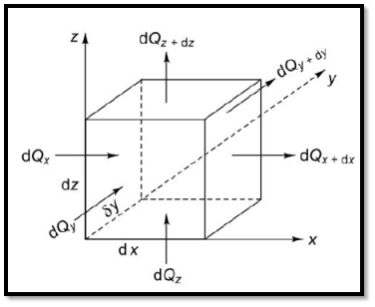
Fig. 1 Volume element for determining heat conduction equation
According to the Fourier heat conduction law, the heat flowing into the left-most face of the element in the x-direction

The value of the heat flow out of the right face of the element can be obtained by expanding dQx in a Taylor series and retaining only the first two terms as an approximation:

The net heat flow by conduction in the x-direction is therefore


Similarly,


Here, the solid has been assumed to be isotropic and homogeneous with properties uniform in all directions. Let us consider that there is some heat source within the solid, and heat is produced internally as a result of the flow of electrical current or nuclear or chemical reactions. Let qG is the rate at which heat is generated internally per unit volume (W/m3). Then the total rate of heat generation in the elemental volume is

The net heat flow owing to conduction and the heat generated within the element together will increase the internal energy of the volume element. The rate of accumulation of internal energy within the control volume is

Where c is the specific heat and  is the density of the solid.
is the density of the solid.
An energy balance can be achieved on the volume element as:
Rate of energy storage within the solid = Rate of heat influx – Rate of heat outflux + Rate of heat generation
Or



 …(1.4)
…(1.4)
Where  is the thermal diffusivity of the solid given by
is the thermal diffusivity of the solid given by  k/
k/ . The larger the
. The larger the
Value of  , the faster heat will diffuse through the material.
, the faster heat will diffuse through the material.
This is heat balance equation in Cartesian form.
If the temperature of a material is not a function of time, the system is in the steady state and does not store any energy. The steady state form of a three-dimensional conduction equation in rectangular coordinates is
 …(1.5)
…(1.5)
It is known as Poisson’s equation.
If the system is in steady state and no heat is generated internally, the conduction equation further simplifies to
 …(1.6)
…(1.6)
This is known as Laplace equation.
Consider heat flow in x-direction only with no heat generation. Hence Laplace equation reduces to
 …(1.7)
…(1.7)
This equation is known as one dimensional heat conduction equation with no heat generation.
Heat conduction equation in cylindrical co-ordinates

Fig 2 Heat conduction in cylindrical element
For a general transient three-dimensional heat conduction problem in the cylindrical coordinates with T = T (r, q, z, t)
By substituting x=rcos , y=rsin
, y=rsin and z=z equation (1.4) becomes
and z=z equation (1.4) becomes
 …(1.8)
…(1.8)
Considering material as isotropic and heat transfer occurring to be one dimensional in steady state equation reduces to
 …(1.9)
…(1.9)
This equation is known as one dimensional heat conduction equation with no heat generation in cylindrical co-ordinate system.
Heat conduction equation in spherical co-ordinates

Fig 3. Heat conduction in spherical element
Consider a spherical element with co-ordinate (r, ,
, )
)
Substitute 


 …(1.10)
…(1.10)
Considering material as isotropic and heat transfer occurring to be one dimensional in steady state equation reduces to

This equation is known as one dimensional heat conduction equation with no heat generation in spherical co-ordinate system.
- Heat flow has an analogy in the flow of electricity. Ohm’s law states that the current I (Ampere) flowing through a wire is equal to the voltage potential E1 – E2 (V), divided by the electrical resistance R

- Since the temperature difference and heat flux in conduction are similar to the potential difference and electric current respectively, the rate of heat conduction through the wall can be written as

Where Rk=L/KA is conductive thermal resistance offered by thermal wall.

Fig 4.
Heat transfer in plane wall
From Fourier law,

From fig 4, at x=0, T=T1
At x=L, T=T2
On integrating,

Conductive resistance R=
Heat transfer by convection
By Newton’s law

Where R= is a convective resistance.
is a convective resistance.
Overall heat transfer coefficient
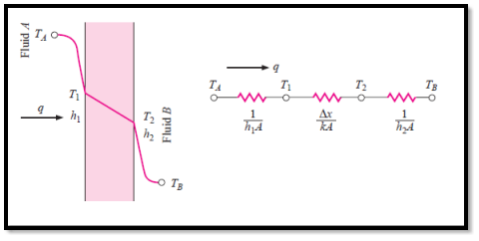
Fig. 5 Overall heat transfer through plane wall
Consider the plane wall shown in Figure 5 exposed to a hot fluid A on one side and a cooler fluid B on the other side. The heat transfer is expressed by

The heat-transfer process may be represented by the resistance network in Figure 5, and the overall heat transfer is calculated as the ratio of the overall temperature difference to the sum of the thermal resistances

The overall heat transfer by combined conduction and convection is frequently expressed in terms of an overall heat-transfer coefficient U, defined by the relation

Where A is area of heat flow and
 …(1.11)
…(1.11)
Resistances connected in series
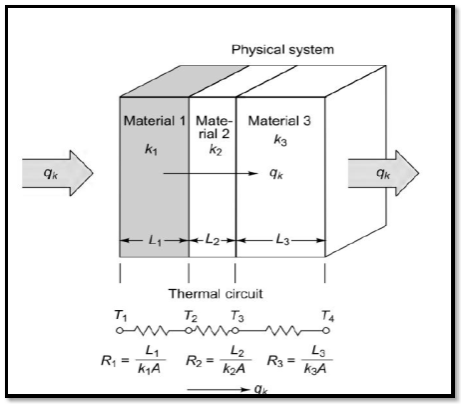
Fig 6 Conduction through three resistances in series
Consider 3 slabs connected in series with endpoints insulated to avoid loss of heat due to convection. This system is equivalent to electric system. Hence,



Resistances connected in parallel
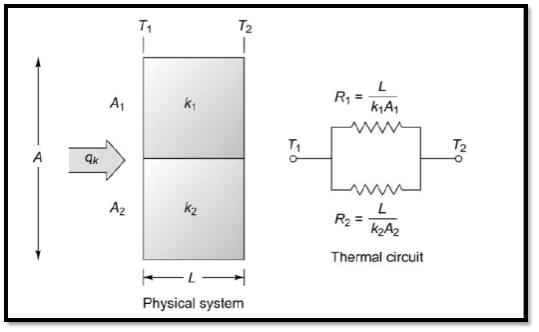
Fig 7 Conduction through three resistances in parallel
Consider 2 slabs connected in parallel with endpoints insulated to avoid loss of heat due to convection. This system is equivalent to electric system connected in parallel. Hence,

 ,
,

Therefore, 
- Heat insulating material is one which has low thermal conductivity.
- Thermal insulation is provided in thermal system to reduce heat losses.
- In case of plane wall, heat transfer rate always decreases with insulation. However, in case of cylinder and sphere, thickness of insulation should be higher than a particular value to reduce heat loss. This value is known as critical radius of insulation
Critical radius of insulation in cylinders
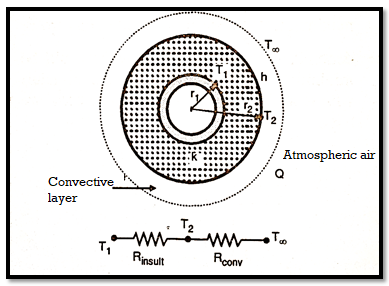
Fig 8 Critical thickness of cylinder
Consider heat flow from metal tube of outside radius r1.It is insulated by layer of insulation with outer radius r2. Let temperature of outside surface of metal tube is T1, conductivity of insulation be k(W/m K). Insulation is exposed to atmosphere at temperature T∞ with convective heat transfer coefficient h(W/m2K) and length L in meters. Now the heat transfer rate through metal tube is
 …(1.14)
…(1.14)
From above equation, it can be seen that with increase in insulation ( heat flow rate Q may decrease or increase with increase in
heat flow rate Q may decrease or increase with increase in  since conductive resistance
since conductive resistance  increase logarithmically but conductive resistance
increase logarithmically but conductive resistance  decrease linearly.
decrease linearly.
To find value of  for which Q is maximum
for which Q is maximum  should be equated to zero. Hence differentiating 1.14 with respect to
should be equated to zero. Hence differentiating 1.14 with respect to  and equating equal to zero.
and equating equal to zero.





 …(1.15)
…(1.15)
Where  is critical radius of insulation.
is critical radius of insulation.
Therefore, at  heat loss will be maximum.
heat loss will be maximum.
At  , heat transfer will increase until
, heat transfer will increase until  increases and becomes equal to
increases and becomes equal to  .
.
If  , heat transfer will go on decreasing and insulation effect will be achieved.
, heat transfer will go on decreasing and insulation effect will be achieved.

Fig 9 Variation of heat transfer with insulation radius
Critical radius of insulation of Sphere
Consider a hollow sphere with outer radius r1 at temperature T1 which is covered with insulation of outer radius r2. Insulation is exposed to atmosphere at temperature T∞ with convective heat transfer coefficient h(W/m2K). Let temperature of outside surface of metal sphere is T1, conductivity of insulation be k(W/m K).
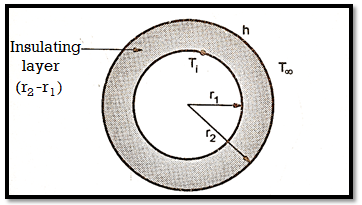
Fig 10 Critical thickness of sphere
From 1.13,

For maximum heat transfer,


Differentiating denominator for it’s minimum value



 (1.16)
(1.16)
Variation in heat transfer with change in radius in insulation is same as of cylinder.
Convection heat transfer between a surface (at T1) and the fluid surrounding it (at  ) is given by
) is given by

Where h is the heat transfer coefficient and A is the surface area of heat transfer.
Consider a plane wall. If T1 is fixed, the heat transfer rate may be increased by increasing the surface area across which convection occurs. This may be done by using fins that extend from the wall into the surrounding fluid.
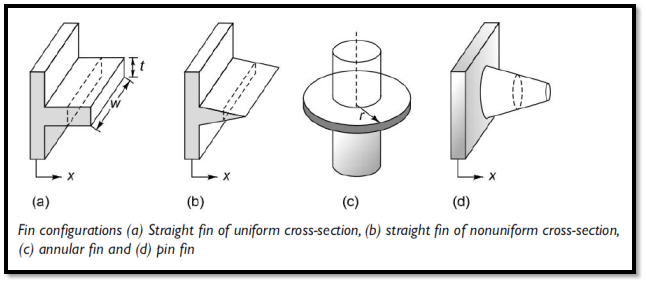
Fig 11 Types of Fins
Analysis of fin of uniform cross-section area(pin-fin)
Consider a thin rectangular fin of uniform cross-section. The fin is attached to base surface at temperature To. Let Ac be cross-sectional area and P be perimeter of fin, is atmospheric temperature and L is length of fin. Following assumptions are made in this analysis:
is atmospheric temperature and L is length of fin. Following assumptions are made in this analysis:
- Heat conduction is along x-axis under steady-state.
- Convective heat transfer coefficient over the fins is uniform.
- There is no heat generation in fin.
- Material of fin is isotropic, hence k is constant.
Heat is conducted from base surface to fin by conduction and from fin to atmosphere by convection simultaneously.
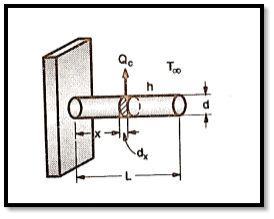
Fig 12 Pin fin
Consider an element section of thickness dx at distance x from base. Let T be be temperature at section.
Heat entering in elementary section,

Heat conducted out from element

Heat convected out of element through thickness dx

By energy balance equation,
Heat conducted into element = Heat conducted out + Heat convected out




 …(1.17)
…(1.17)
Let  and
and 
By differentiating

And

Hence 1.17 becomes

Above equation is second order differential equation. General solution for this equation is
 …(1.18)
…(1.18)
And slope is
 …(1.19)
…(1.19)
In order to find solution of above differential equations we need values of  and
and  . We can obtain solution for following three cases:
. We can obtain solution for following three cases:
- Infinitely long fin
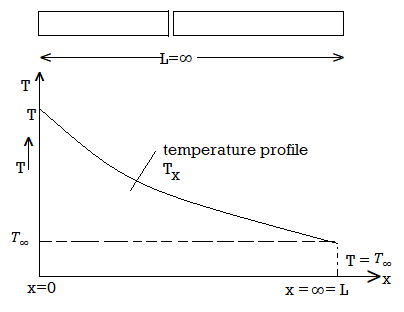
Fig 13 Infinitely long fin
Consider a infinitely long fin as in figure such that temperature at the end of fin approaches surrounding temperature  .
.
At  hence
hence  .
.
At 
Applying boundary condition 1 to 1.18 …(1.20)
…(1.20)
Applying boundary condition 2 to 1.18


Hence  . Putting this value in 1.20
. Putting this value in 1.20

Substituting values of  and
and  in 1.18
in 1.18
 …(1.21)
…(1.21)


 …(1.22)
…(1.22)
This represents temperature distribution on infinitely long fin.
Heat transfer at base is equal to heat transfer through fin. Hence, at base(x=0)

From 1.21

As x=0


 …(1.23)
…(1.23)
2. Adequately long fin with insulated fin
Boundary conditions are
At  hence
hence  .
.
At 
Applying first boundary condition on 1.18
 …(1.24)
…(1.24)
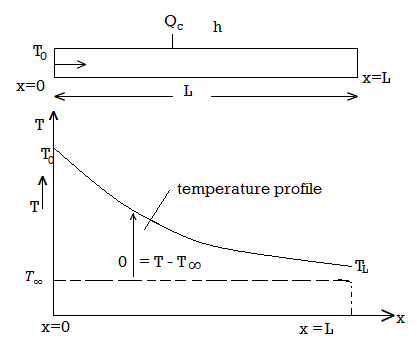
Fig 14 Insulated fin
Applying second boundary condition on 1.19

 …(1.25)
…(1.25)


From 1.25

Substituting C1 and C2 in 1.18



But 
 …(1.26)
…(1.26)
This represents temperature distribution on insulated long fin.
Heat transfer at base is equal to heat transfer through fin. Hence, at base(x=0)

From 1.26


Therefore at x=0

 …(1.27)
…(1.27)
3. Short Fin
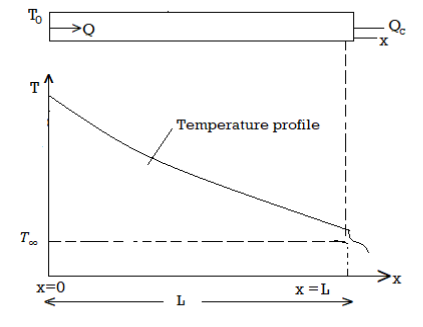
Fig. 15 Short fin
Boundary conditions are
At  hence
hence 
At 
 is heat convected away to surrounding.
is heat convected away to surrounding.
From second boundary condition at x=L,

From 1.18 and 1.19



 …(1.28)
…(1.28)
Putting boundary condition 1 in 1.18

Solving this equation and 1.28


Putting these values in 1.18

At x=L and 

This represents temperature distribution on short fin.
 at x=0
at x=0
Substituting 


 …(1.29)
…(1.29)
Effectiveness of fin
- Fins are used to increase heat transfer but fin itself blocks the base area on surface and acts as resistance to heat conduction.
- It not sure whether fin is helping in heat transfer or not hence the term effectiveness is used.
- Effectiveness is ration of actual heat transfer rate by fin to heat transfer by the area blocked by fin.



For infinitely long fin tanhmL=1

Fins are used only if 
- After the heat transfer process is initiated some time must elapse before steady-state is reached. During this period the temperature changes until body attains steady-state. This period during which temperature changes with time is called transient state or unsteady state.
- Conduction of heat in this state is transient heat conduction.
Lumped system approximation
- Even though no material in nature has an infinite thermal conductivity, many transient heat flow problems can be readily solved by assuming that the internal conductive resistance of the system is very small and the temperature within the system at any instant is uniform. This method is called lumped system approximation.
- This is justified when the external thermal resistance between the surface of the system and the surrounding fluid is so large compared to the internal thermal resistance that it controls the rate of heat transfer.
- In order know whether not to use lumped mass approximation, a dimensionless number is used known as Biot number (Bi).
- Biot number is measure of the relative importance of the thermal resistance within a solid body, which is the ratio of internal to external thermal resistance.

Where h is the average heat transfer coefficient, L is a characteristic dimension obtained by dividing the volume of the body by its surface area and k is the thermal conductivity of the solid body. For Bi < 0.1, i.e. when the internal resistance is less than 10% of the external resistance, the internal resistance can be ignored and lumped system approximation can be used.
Heisler charts
- Solution to unsteady state problems is worked out by lumped method if internal resistance of solid can be neglected. It can be done only if Bi<0.1.
- In case Bi>0.1, some another method needs to be applied. Heisler worked out analytical solutions of such problems in form of charts for standard shapes like cylinder, slabs and spheres.
- If 0.1<Bi<100, Heisler charts give very good accuracy.
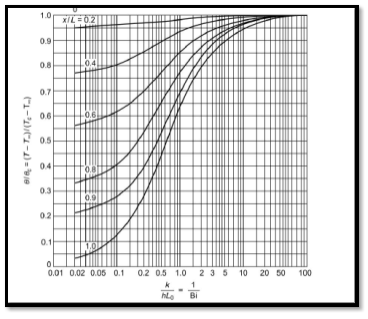
Fig 16 Temperature as a function of centre temperature in an infinite plate of thickness 2L
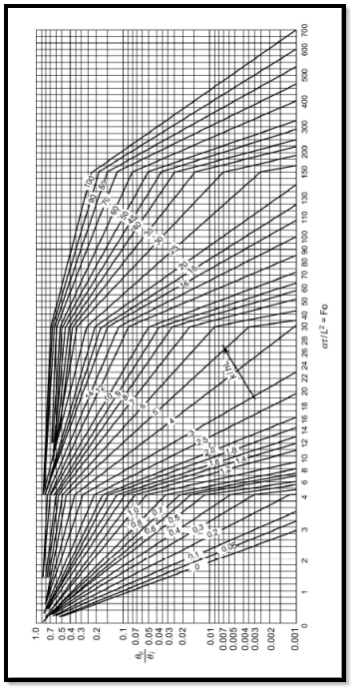
Fig 17 Axis temperature for infinite plate with thickness 2L
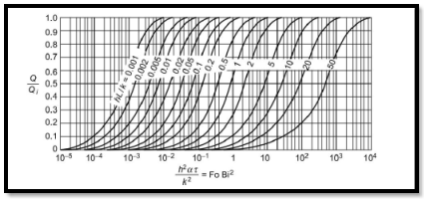
Fig 18 Heat loss of an infinite plate of thickness 2L with time
These are Heisler charts for cylinder where,
Fo = Fourier number
Bi=Biot number
 =Thermal diffusivity
=Thermal diffusivity
h= convective heat transfer coefficient
Q=Heat transfer rate
Qi=Heat transfer rate at t=0
t=time
When the boundaries of a system are irregular or the temperature along a boundary is non-uniform, a one-dimensional treatment may not be satisfactory. Temperature here may be a function of two or even three coordinates.
The components of the heat flow per unit area (heat flux) q in the x and y-direction are obtained from Fourier’s law:

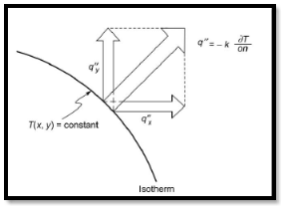
Fig 19 Heat flow in two dimensions
The heat flux q at a given point (x, y) is the resultant of the components qx and qy at that point and is directed perpendicular to the isotherm (Fig. 20). If the temperature distribution in a system is known, the rate of heat flow can easily be calculated.
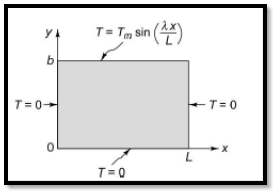
Fig. 20 Rectangular adiabatic plate with sinusoidal temperature distribution on one edge
Let us consider a simple case of a thin rectangular plate (Fig. 20), free of heat sources and insulated at the top and bottom surfaces. Since ∂T/∂z =0, the temperature is a function of x and y only. If k is uniform, the temperature distribution must satisfy Eq. (2.134), a linear and homogeneous partial differential equation that can be integrated by assuming a product solution for T(x, y) of the form
 …(1.30)
…(1.30)
Where X = X(x), a function of x only, and Y = Y(y), a function of y alone. Differentiating above equation twice, first with respect to x and then with respect to y.

Substituting this values in 1.30


The variables are now separated. The LHS is a function of x only, while the RHS is a function of y alone. Since neither side can change as x and y vary, both must be equal to a constant, say  . We have, therefore, two ordinary differential equations
. We have, therefore, two ordinary differential equations


Solutions to above differential equations are

And

Respectively. Substituting these values in 1.30
 …(1.31)
…(1.31)
Where C1, C2, C3 and C4 are constants to be evaluated from the boundary conditions. As shown in Fig, the boundary conditions to be satisfied are
 at x=0
at x=0



Substituting third condition in 1.31
 …(1.32)
…(1.32)
Substituting first condition in 1.31
 …(1.33)
…(1.33)
Substituting second condition in 1.31
 …(1.34)
…(1.34)
Solving 1.33,  , solving 1.32, we get
, solving 1.32, we get 
Using these results in 1.34



To satisfy this condition, sin  L = 0 or,
L = 0 or,  =
= , where n = 1, 2, 3, …. There exists, therefore, a different solution for each integer n, and each solution has a separate integration constant Cn. Summing these solutions
, where n = 1, 2, 3, …. There exists, therefore, a different solution for each integer n, and each solution has a separate integration constant Cn. Summing these solutions
 …(1.35)
…(1.35)
The last boundary condition needs that at y=b


Putting this value in 1.35
 …(1.36)
…(1.36)
For regular shaped bodies, analytical methods in the form of Heisler’s charts can be used to determine the time-temperature history.
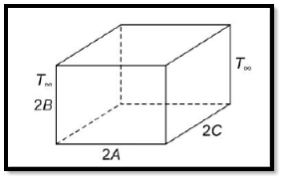
Fig. 21 A parallelepiped being heated or cooled
Let us consider a rectangular parallelepiped with dimensions 2A, 2B and 2C, which is initially at a uniform temperature Ti and then subjected to a constant surrounding temperature  (Fig. 21).
(Fig. 21).
Fourier’s heat conduction equation in absence of any heat source is given by

The solution may be broken up into factors so that

Substituting above mentioned factors in fourier equation


By rearranging

…(1.37)
Equation 1.37 will be satisfied only if



But these are simply three one-dimensional forms of Fourier’s equation, so that the solution to the three-dimensional problem may be expressed as the product of three solutions of one-dimensional problems.
From Heisler’s charts for infinite plates, ( /
/ )A, (
)A, ( /
/ ))B and (
))B and ( /
/ ))C are found out. The product of these three will give the centre temperature of the parallelepiped
))C are found out. The product of these three will give the centre temperature of the parallelepiped

From which  at any time t can be estimated.
at any time t can be estimated.
Similarly, for any other point inside the parallelepiped the time-temperature history can be found out by using the position-correction charts.
- Heisler charts are a graphical analysis tool for the evaluation of heat transfer in thermal engineering. They are a set of two charts per included geometry introduced in 1947 by M. P.
- Heisler which were supplemented by a third chart per geometry in 1961 by H. Gröber. Heisler charts permit evaluation of the central temperature for transient heat conduction through an infinitely long plane wall of thickness 2L, an infinitely long cylinder of radius ro, and a sphere of radius ro.
- These first Heisler-Gröber charts were based upon the first term of the exact Fourier Series solution for an infinite plane wall:

Where Ti is the initial temperature of the slab, T∞ is the constant temperature imposed at the boundary, x is the location in the plane wall, λn is π(n+1/2), and α is thermal diffusivity. The position x=0 represents the center of the slab.
Limitations
Although Heisler-Gröber charts are a faster and simpler alternative to the exact solutions of these problems, there are some limitations. First, the body must be at uniform temperature initially. Additionally, the temperature of the surroundings and the convective heat transfer coefficient must remain constant and uniform. Also, there must be no heat generation from the body itself.
Importance of numerical methods
- The overall goal of the field of numerical analysis is the design and analysis of techniques to give approximate but accurate solutions to hard problems, the variety of which is suggested by the following:
- Advanced numerical methods are essential in making numerical weather prediction feasible.
- Computing the trajectory of a spacecraft requires the accurate numerical solution of a system of ordinary differential equations.
- Car companies can improve the crash safety of their vehicles by using computer simulations of car crashes. Such simulations essentially consist of solving partial differential equations numerically.
The Biot and Fourier Numbers
The temperature profiles and heat flows may all be expressed in terms of two dimensionless parameters called the Biot and Fourier numbers:
Biot number (Bi) 
Fourier number 
All value of the Bi no. Means that internal conduction resistance is negligible in comparison with surface-convection resistance.
All value of Fo no. Means that along period of time is required to heat or cool the body.
Example: A steel plate (k=41 W/m.K, 5cm thick) is initially at a temperature of 425°C. Its suddenly exposed on path side to a convention environment with h = 285 W/m2 .K and T∞ = 65°C. Determine the centre line temperature and the temperature inside the body 1.25cm from the surface after 24min. α=1.172 ×10-5 m2 /s
Solution



At 

Example: Along 6.5cm diameter solid cylinder steel (k=16.3 W/m.K, ρ=7817 kg/m3 , cp=460 J/kg.K). It's initially a uniform temperature Ti = 150°C. It's suddenly exposed to a convective environment at T∞ = 50°C and h = 285 W/m2.K. Calculate the temperature at 1) the axis of cylinder, and 2) a 2.5cm radial distance after 5min of exposure to the cooling flow 3) determine the total energy transferred from the cylinder per meter length during the first five min. Of cooling.
Solution





1) 
2) At 
3)





Example: A fused quartz sphere has a thermal diffusivity of 9.5 ×10-7 m 2 /s. a diameter of 25mm and k=1.52 W/m.K. The sphere is initially at a uniform temperature Ti = 25°C. It's suddenly subjected to a convection environment at T∞ = 200°C and h = 110 W/m2.K. Calculate the temperature at the centre and at the radius of 6.4mm after 4min.
Solution





Important Formulae
Conductive heat transfer |  |
Convective heat transfer |  |
Radiation heat transfer |  |
Heat balance equation |  |
Conductive thermal resistance |  |
Convective thermal resistance |  |
Total thermal resistance of bodies connected in series | 
|
Total thermal resistance of bodies connected in parallel |  |
Heat transfer through cylinder |  |
Heat transfer through sphere |  |
Critical insulation radius of cylinder |  |
Critical insulation radius of sphere |  |
Heat transfer through infinitely long fin |  |
Heat transfer through fin with insulated tip | 
|
Heat transfer through short fin |  Or  |
Effectiveness of fin | 
|
Biot number |  |
References:
1. A. Bejan, Heat Transfer John Wiley, 1993
2. J.P. Holman, Heat Transfer, Eighth Edition, McGraw Hill, 1997.
3. F.P. Incropera, and D.P. Dewitt, Fundamentals of Heat and Mass Transfer, John Wiley, Sixth Edition, 2007.
4. Massoud Kaviany, Principles of Heat Transfer, John Wiley, 2002